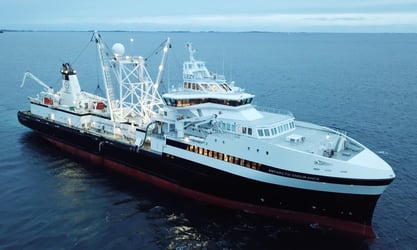In April of 2022, we brought FlowCam to NACE, the Northeast Aquaculture Conference and Exhibition, in Portland, Maine, a stone's throw from our FlowCam headquarters in Scarborough. FlowCam is frequently used in aquaculture operations to detect harmful algae and to monitor the health and growth of larvae.
About 15 conference attendees had the opportunity to take a side trip to tour the aquaculture facilities at the University of New Hampshire (UNH), not far away. That morning we caravanned down to UNH's Judd Gregg Marine Research Complex in New Castle, New Hampshire. The complex is located at the mouth of the Piscataqua River and shares space with a US Coast Guard base. After a quick round of introductions, our guides, Erich Berghahn and Michael Doherty, brought us to the Coastal Marine Laboratory (CML). Here, we learned about lump fish (pictured above), a species found in the Gulf of Maine that has been used as a cleaner fish to remove sea lice from farmed salmon. At the CML, we saw lump fish of all sizes and saw how they are cultivated in the lab for research.
.png?width=417&name=MicrosoftTeams-image%20(6).png)
After saying goodbye to the lump fish, we moved outside to the Marine Research Pier. Here, we got to see UNH's integrated multi-trophic aquaculture, or IMTA, operations. IMTA refers to the practice of growing multiple species, such as kelp, trout, and mussels on a single platform. The platform at UNH, called the AquaFort (pictured here), had not yet been deployed for the season, but we had an opportunity to see it and ask questions.
According to UNH's website,
"New Hampshire Sea Grant’s AquaFort serves as an offshore aquaculture training platform and research site. The AquaFort research program recruited local fishermen and farmers from NH, ME, and MA to participate in workshops and daily operations of an offshore aquaculture farm. During this period (2018-2020) the AquaFort was constructed and deployed, and two seasonal grow-out trials were conducted. Participants benefit from hands-on training in:
|
|
After visiting the AquaFort, we finished the day with a short boat ride to check out where UNH is growing kelp. It was a relatively calm (though cold) day, with great views of the local lighthouse and loons.
.png?width=792&height=594&name=MicrosoftTeams-image%20(7).png)
Pictured below is a water sample taken near the kelp farm, captured on FlowCam 8100 in Autoimage mode with a 10X objective and 100um FOV flow cell. 
FlowCam is now frequently used in aquaculture operations. Whether monitoring for harmful algae, assessing food supply, or determining the health and viability of larvae, farm and hatchery managers can now analyze water samples significantly faster than before.
For the farmer, FlowCam can be used for HAB monitoring as well as evaluating the productivity and plankton availability for food supply when performing site evaluations.
In the hatchery, FlowCam has many uses. The instrument can be used to keep track of the health of the larvae by looking at high-resolution images and abnormalities can be quickly assessed. The vital stain Neutral Red can be added to samples to determine the ratio of live/dead larvae, and the hatchery manager can monitor the concentration of the algae being fed to the larvae.












